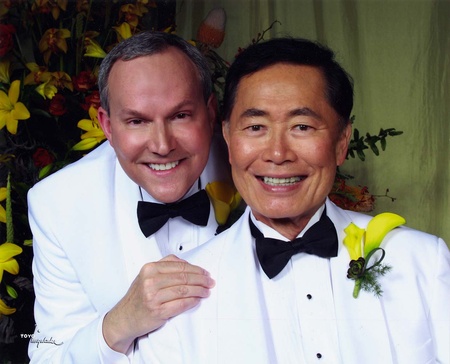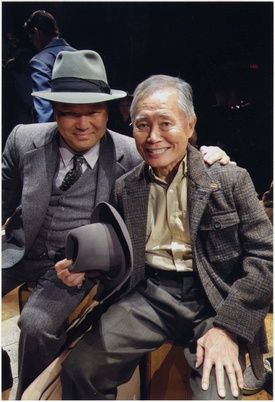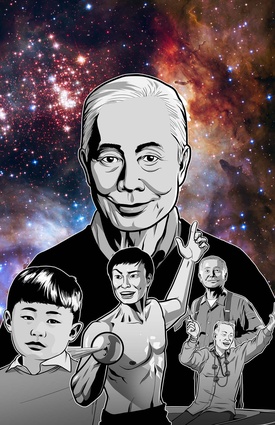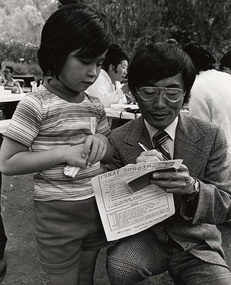Like many people, and especially many Japanese Americans, I’m a big fan of George Takei. I’ve followed his career since I first saw him in the role of Lieutenant Hikaru Sulu in the original 1960s television Star Trek series and as he reprised the character in subsequent Star Trek movies in the 1970s and 1980s. Instead of fading into pop culture history after the Star Trek movies, he’s reinvented himself in both politics and pop culture, and today he’s hands-down the best-known and influential Asian American and an activist for human rights.
The Japanese American National Museum (JANM) has honored Takei with an exhibition, New Frontiers: The Many Worlds of George Takei that closes August 20, 2017. Takei is a member of the museum’s Board of Trustees, and is a vocal supporter of the institution. JANM returns the favor with this overview of Takei’s epic career, from acting to activism, and his current status as a social media superstar. I wish I lived in Los Angeles so I could see the exhibition!
The Sulu character was a turning point not just for Takei, but for Asian Americans. As part of producer Gene Roddenberry’s vision for a diverse future, Takei’s character was the first AAPI character whose role didn’t rely on his ethnicity. Star Trek debuted in 1966, the same year as The Green Hornet co-starring Bruce Lee as a martial-arts fighting sidekick. Before that, Americans saw Victor Sen Yung as the subservient frontier family cook on 102 episodes of Bonanza between 1959 and ’73. The other familiar Asians were comedic foils like Hawaii-born Filipino American actor Poncie Ponce, cast as the ukulele-playing cabbie Kazuo Kim in the police series Hawaiian Eye (1959–’63), or Yoshio James Yoda, who played the hapless POW/houseboy/mascot Fuji in the sitcom McHale’s Navy (1962–’66).

(George & Brad Takei Collection, Japanese American National Museum.)
Sulu was not an Asian stereotype. Even the name was not typical. The surname was chosen by Roddenberry because he thought it sounded pan-Asian—the character’s Japanese first name “Hikaru” came much later, in a 1981 book, and was first spoken in the 1991 movie Star Trek VI: The Undiscovered Country. The character was serious (but not bookish), handsome and intense (not nerdy and detached), and important (he was chief helmsman in the original series and later captain of his own starship in the movies). Sulu was even sexy.
Takei was perfect for the role—he exuded strength and reliability. He was one of the core crew members of the Enterprise, alongside a Russian, an African American, a Scotsman, and … a Vulcan.

(George & Brad Takei Collection, Japanese American National Museum.)
Takei already had an impressive acting resume, though in supporting roles that weren’t recurring. He was born in 1937 in Los Angeles and was five when his family was incarcerated during World War II. After the war, he went to junior high and high school back in LA, and studied acting and theater. Blessed with a wonderful baritone, he did voiceover dubbing for a Japanese Godzilla movie. His first TV roles were on Playhouse 90 and Perry Mason, and later he was in a 1964 Twilight Zone episode as well as a 1966 Mission Impossible episode. But Star Trek sealed his fame.
After the original TV series ended in 1969, Takei began a parallel presence in politics and activism. He was an alternate delegate to the Democratic National Convention in 1972, and in 1973 he ran an unsuccessful campaign for LA city council. He was appointed to the Southern California Rapid Transit District and served from 1973 to 1984. He continued acting through the decades, co-starring in six Star Trek films and other smaller roles. More recently, he appeared on all four seasons of the television series Heroes as the main character Hiro Nakamura’s father Kaito Nakamura.
In 2005, Takei announced that he had been in a relationship with now-husband Brad Altman (now Takei) for 18 years, and he’s been an outspoken supporter of the LGBTQ community and LGBTQ issues since. The first time I met Takei in person was when JANM held an “ALL-Camp Summit” in Denver in 2008. The Consul General of Japan hosted a welcome reception for the conference and George and Brad attended. It was amazing to hear that iconic voice speak Japanese.

(George & Brad Takei Collection, Japanese American National Museum.)

(George & Brad Takei Collection, Japanese American National Museum.)
I got to interview Takei in 2015, when he premiered the latest chapter of his long career, as a Broadway musical star. He was promoting Allegiance, a powerful musical about the JA incarceration that was written and produced by Jay Kuo and Lorenzo Thione, based in part on Takei’s childhood in the concentration camp.
“I’m always shocked when I tell the story (of Japanese American incarceration) to people that I consider well-informed,” Takei said at the time, “and they’re shocked and aghast that something like this could happen in the United States. It’s still little-known. So, it’s been my mission to raise the awareness of this chapter of American history.”
In an after-show talk with audience members, Takei recalled why Allegiance is so important today. “I remember we started the school day, each day, with the Pledge of Allegiance to the flag. I could see the barbed wire fence and the sentry tower right outside my school house window as I recited the words, ‘with liberty, and justice for all.’”
During the musical’s run, Donald Trump won the presidential election, and as controversies erupted over Trump’s anti-Muslim stance, Takei invited him to come see the play. He never did. Takei also invited the mayor of Roanoke, Virginia to see the musical when he cited the Japanese American incarceration as a model for how to treat Syrian refugees. He didn’t come either.
The musical ran for five months on Broadway, and was screened twice for a national audience in movie theaters in a well-directed multicamera presentation. Now, Takei’s preparing to bring the musical to the stage in Los Angeles, for a run from February 21–April 1 at the Japanese American Cultural & Community Center’s (JACCC) Aratani Theater in Little Tokyo, co-presented by JACCC and East West Players.
After the initial run of Allegiance, Takei managed to squeeze in time to perform in an off-Broadway production of Pacific Overtures, a Stephen Sondheim musical about the westernization of Japan in the mid-1800s. I first saw the original Broadway production of Pacific Overtures when I was a college student in the 1970s. I wish I could have seen Takei in it. He was also the voice of Hosato in the animated film Kubo and the Two Strings. Because of the JANM exhibition, he’s now immortalized in a manga produced by exhibition curator Jeff Yang and Keith Chow. How cool is that?
Amidst all this work, Takei, who is now 80, maintains a brilliant profile as a social media superstar with over 10 million people liking and following his Facebook page. He shares political posts, news about Allegiance and his other projects, updates about his social activist activities, and lots and lots of funny, weird, and poignant social media memes (one recent favorite is a link to how Game of Thrones actors find out they’re about to die; another is a litany of hilarious photos of people unknowingly wearing clothes that give rude messages).
On all fronts, Takei is exploding with creative energy. He is the most visible Asian American and the most famous Japanese American in pop culture. He has truly gone where no man has gone before, and has lived a long and prosperous life.
New Frontiers: The Many Worlds of George Takei continues at JANM through August 20, 2017.
© 2017 Gil Asakawa









